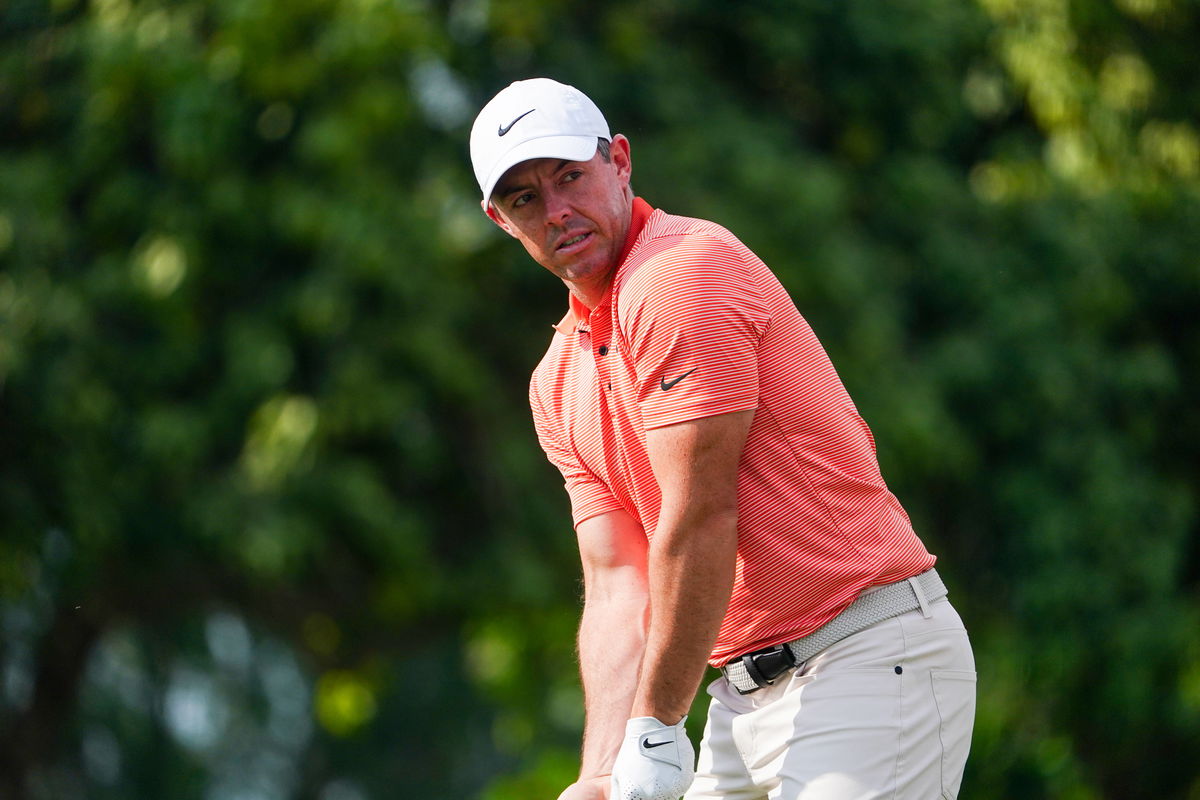
Imago
Hero Dubai Desert Classic Rory McIlroy NIR on the 13th tee during the final round of the Hero Dubai Desert Classic, Emirates Golf Club, Dubai, United Arab Emirates. 19/01/2025 Picture: Golffile Fran Caffrey All photo usage must carry mandatory copyright credit Golffile Fran Caffrey Copyright: xFranxCaffreyx *EDI*

Imago
Hero Dubai Desert Classic Rory McIlroy NIR on the 13th tee during the final round of the Hero Dubai Desert Classic, Emirates Golf Club, Dubai, United Arab Emirates. 19/01/2025 Picture: Golffile Fran Caffrey All photo usage must carry mandatory copyright credit Golffile Fran Caffrey Copyright: xFranxCaffreyx *EDI*
Before we get into the debate on why Signature Events aren’t working, let’s take a moment to understand what they actually are and how they work. Back in 2022, LIV Golf had just entered the scene, throwing around $25 million purses and grabbing headlines by attracting some of the world’s top players with huge signing bonuses. The PGA Tour needed an answer, and it was elevated purses.
Watch What’s Trending Now!
So, in 2023, it launched the “Designated Events,” which had 9 tournaments with elevated purses of around $20 million. Initially, these events had field sizes similar to regular events, traditional formats, and 36-hole cuts. But by 2024, the model had shifted. Now, it was eight events to what we now know as “Signature Events,” where the fields became smaller (70-80 players), with no cuts in five of the eight events, and a bump in FedEx Cup points for winners (700 instead of 500).
The idea was to create more frequent, elite showdowns between top players. The entry in these events is limited to the top 50 in the prior season’s FedEx Cup standings, plus a few new pathways like the Aon Next 10 and Aon Swing 5, which reward players in form. A handful of sponsor exemptions are also granted, and the Tour stagger these events across the schedule all year long. While the concept sounds strong on paper—rewarding performance, ensuring star-studded fields, and increasing fan interest—the reality has been far more complicated.
ADVERTISEMENT
In August, when Brian Rolapp unveiled the direction for the Tour, he promised big changes. Per him, the Tour needed a “clean sheet” approach, one that would focus on three core ideas—parity, scarcity, and simplicity. But as fans, players, and media look closer at the changes and the Tour’s current model, especially the Signature Events, it is clear that it isn’t the way it should be. Signature events were to showcase the most elite golfers. Instead, it has drawn criticism for being non-inclusive, inconsistent, and even boring. And as for Rolapp’s vision of “significant change”? It might be heading in the wrong direction.
Let’s understand why.
Top Stories
Suspended PGA Tour Player Declines to Blame LIV Golf for Jay Monahan’s Decision

How Did Golf Legend Fuzzy Zoeller Die? All About 74-YO’s Cause of Death

Charley Hull Calls for Public Help After Her Golf Clubs Are Stolen in Broad Daylight

Phil Mickelson Was Right All Along About PGA Tour’s Strict Restrictions as Suspended Pro Opens Up

Calls Mount Against Tiger Woods’ Bizarre Thanksgiving Feature With ‘Biased’ Stance: ‘This Sucks’

ADVERTISEMENT
Brian Rolapp’s Vision vs. the Tour’s Structure
When Brian Rolapp stepped into his role as CEO of the PGA Tour, he promised to fix what wasn’t working. Fans weren’t as engaged. Players were getting frustrated. The Signature Events, supposed to be the Tour’s crown jewels, were under-delivering. Something had to change.
The new committee’s three main principles made sense on paper. Scarcity means the biggest stars playing together more often in ‘special events,’ simplicity means making the schedule and the season easier for fans to follow, while parity means giving more players a fair shot, or in other words, maintaining the Tour’s meritocratic structure. But there’s the problem.
ADVERTISEMENT
Scarcity and parity don’t really get along. You can’t shrink field sizes and still claim everyone has a fair shot. You can’t push meritocracy while increasing sponsor exemptions and no-cut formats. Rolapp wants the Tour to feel special and exclusive, but most players just want things to be fair. And when the best players already dominate the points, money, and coverage, narrowing the door to get into big events only makes it worse.
Rolapp says the gap between the top 5 and the next 30 players is razor-thin. He’s probably right. But the Signature Events aren’t reflecting that belief. Instead, they’re rewarding names, not form, and creating a system where a small group of players keep getting richer opportunities, while the rest fight for scraps. And that growing tension is now bubbling to the surface.
ADVERTISEMENT
The Growing Issue of Signature Events: Field Cuts & Fewer Qualifiers
As Signature Events have evolved, so has the frustration surrounding them. Critics argue that these events have slowly chipped away at the Tour’s identity—a place where anyone with game could earn their way in. And the most obvious issue? Smaller field sizes.
With most Signature Events capped at around 70–80 players, and only three of them having a cut (The Genesis, Arnold Palmer Invitational, and The Memorial), fewer players even get the chance to compete. And now, with the rollout of the 2026 calendar, there’s an additional signature event that will happen in Miami, taking the tally to 9, contradicting Rolapp’s pillar of simplicity.
While the Tour argues this will improve the viewing experience and highlight top talent, many players see it differently. The limited access feels anything but fair competition. Even the format of these Signature Events has dulled the competitive edge. With no cut in most events, players are guaranteed a paycheck, even if they finish near the bottom, feeling more like exhibitions than true tests. And fans have noticed it too.
ADVERTISEMENT
Despite the star-studded fields, 2025’s most memorable moments didn’t come from Signature Events. They came from the WM Phoenix Open, which is known for drawing enthusiastic crowds, particularly on the famous 16th hole, The Coliseum. Or the Mexico Open, where a surprise playoff between two underdog names, Brian Campbell & Aldrich Poltgeiter, kept everyone on the edge of their seats. Or even when Scottie Scheffler finally won his first title of the season at his hometown—not at a Signature Event, but at the CJ Cup Byron Nelson in Texas.
Projected Eligibility for 2026 PGA Tour Full Exempt Status and First Signature Events Entry.
• All players in left 2 columns are guaranteed exempt for 2026 Season
• Far left Column is exempt for all Signature Events
• 2nd and 3rd Column players in BLUE are exempt for 2026,… pic.twitter.com/1gX64eQsDD
— Robopz (@Robopz) September 5, 2025
And then there’s also the issue of players not showing up. If Signature Events are supposed to be the most important tournaments outside the majors and The Players Championship, you’d expect top players to treat them that way. But that hasn’t really happened. This season, Rory McIlroy skipped three Signature Events — The Sentry, RBC Heritage, and even The Memorial. Scheffler, too, skipped the Truist Championship. If players themselves don’t treat these events as must-play events, how can fans be expected to treat them with all seriousness?
A Model That’s Exclusionary and Unfair
But perhaps the biggest lightning rod in this debate has been sponsor exemptions and how they’re being used. Each Signature Event allows four sponsor invites, restricted to PGA Tour members, plus one host exemption at player-hosted events. In theory, it gives tournament organizers flexibility to invite players with star power, local ties, or recent form. In reality, it’s become a loophole and a sore spot for many on Tour.
Take Rickie Fowler, for example. In 2025, he received six sponsor exemptions into Signature Events despite finishing 108th in the previous season’s FedEx Cup standings — well outside the automatic qualification criteria. He earned nearly half his total FedEx Cup points through those invites (319 of 665 points). Jordan Spieth received five sponsor invites and also racked up a significant chunk of his season’s points through them. Meanwhile, higher-ranked players sat at home. For players grinding week to week, this cuts deep.
Critics argue that the Signature Events feel more like a members-only club than a competition.
Veteran Lucas Glover didn’t hold back. Speaking during the Arnold Palmer Invitational, he said, “I don’t like the idea at all. It’s selfish and it’s a money grab.” He slammed the addition of another Signature Event in 2026, the Miami Championship, saying, “They added another Signature Event and took another full-field event out. That’s what made me realize that it wasn’t changing, it was going to get worse.”
Even Erik van Rooyen, known for being more measured, didn’t hide his frustration. “How honest do you want me to be? I hate it,” he said when asked about the Signature Event structure. “I strongly believe that the strongest fields are the ones with the most players in them,” he said, before the Truist Championship earlier this year.
Both players echoed a growing sentiment that the Tour is becoming a two-tier system — one for the stars, and one for everyone else. And for a sport that prides itself on merit, that’s a problem.
Why Signature Events Need to be Rethought
The PGA Tour had good intentions when it launched the Signature Events. Faced with a real threat from LIV Golf, it needed a solution that would keep its top players engaged, protect its commercial value, and give fans big-time matchups more often. But what looked good on paper hasn’t landed the way it should in reality.
Instead of raising the overall quality of the Tour, the Signature Events have raised new questions — about fairness, accessibility, and whether this new structure is actually growing the game or just protecting a select few. It’s hard to sell the idea of “the best competing against the best” when sponsor exemptions and shrinking fields mean some of the best are left out altogether.
The Tour now finds itself in a strange spot. It’s pushing for scarcity and star power, but also preaching meritocracy and parity. Those things don’t always coexist, and the Signature Events have exposed that reality in a big way. Rolapp and his committee have a big task ahead: figuring out whether they want a tour based on just big names or a tour based on merit. Whatever direction they choose, one thing is clear — Signature Events, as they stand, aren’t the solution.
ADVERTISEMENT
ADVERTISEMENT
ADVERTISEMENT

